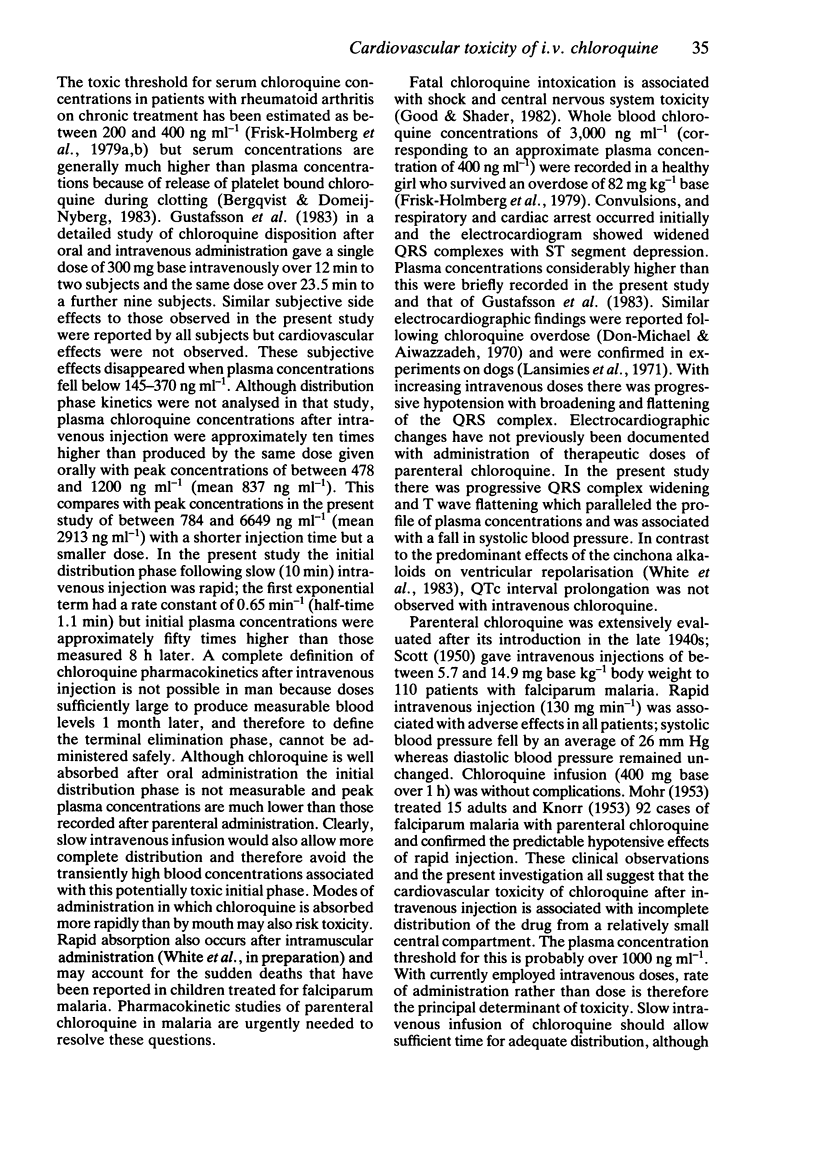Abstract
Chloroquine diphosphate (3 mg base kg-1) was given by constant rate intravenous injection over 10 min to 12 healthy adult male volunteers. Plasma concentrations of chloroquine and the principal metabolite desethylchloroquine, electrocardiograph intervals, and arterial blood pressure were measured at frequent intervals to determine the relationship between cardiovascular effects and plasma concentrations. Peak plasma concentrations ranged between 784 and 6649 (mean 2913) ng ml-1. The decline in plasma concentrations was multiexponential with an initial rapid distribution phase; mean (+/- s.d.) first order rate constant 0.65 +/- 0.14 min-1, and an estimated apparent volume of the central compartment of 0.18 +/- 0.15 l kg-1. There was no serious toxicity, but subjective side effects were reported in all patients and there was a significant fall in systolic blood pressure (110 +/- 9.5 to 101 +/- 12.5 mm Hg; P = 0.03) and rise in heart rate which paralleled the change in plasma chloroquine concentrations. Coincident with changes in blood pressure, there was a significant prolongation of the electrocardiograph QRS interval; 81 +/- 15 to 92 +/- 13 ms (P less than 0.01) but no change in the QTc interval. These findings suggest that the cardiovascular toxicity of parenteral chloroquine is related to transiently high plasma concentrations occurring early in the distribution phase. This results from incomplete distribution from a central compartment that is approximately one thousand times smaller than the eventual total apparent volume of distribution at steady state. Rate of administration is therefore a major determinant of toxicity.
Full text
PDF





Selected References
These references are in PubMed. This may not be the complete list of references from this article.
- Adelusi S. A., Dawodu A. H., Salako L. A. Kinetics of the uptake and elimination of chloroquine in children with malaria. Br J Clin Pharmacol. 1982 Oct;14(4):483–487. doi: 10.1111/j.1365-2125.1982.tb02016.x. [DOI] [PMC free article] [PubMed] [Google Scholar]
- Alván G., Ekman L., Lindström B. Determination of chloroquine and its desethyl metabolite in plasma, red blood cells and urine by liquid chromatography. J Chromatogr. 1982 Apr 16;229(1):241–247. doi: 10.1016/s0378-4347(00)86059-4. [DOI] [PubMed] [Google Scholar]
- Bergqvist Y., Domeij-Nyberg B. Distribution of chloroquine and its metabolite desethyl-chloroquine in human blood cells and its implication for the quantitative determination of these compounds in serum and plasma. J Chromatogr. 1983 Jan 14;272(1):137–148. doi: 10.1016/s0378-4347(00)86110-1. [DOI] [PubMed] [Google Scholar]
- Don Michael T. A., Aiwazzadeh S. The effects of acute chloroquine poisoning with special reference to the heart. Am Heart J. 1970 Jun;79(6):831–842. doi: 10.1016/0002-8703(70)90371-6. [DOI] [PubMed] [Google Scholar]
- Frisk-Holmberg M., Bergkvist Y., Domeij-Nyberg B., Hellström L., Jansson F. Chloroquine serum concentration and side effects: evidence for dose-dependent kinetics. Clin Pharmacol Ther. 1979 Mar;25(3):345–350. doi: 10.1002/cpt1979253345. [DOI] [PubMed] [Google Scholar]
- Frisk-Holmberg M., Bergqvist Y., Englund U. Chloroquine intoxication. Br J Clin Pharmacol. 1983 Apr;15(4):502–503. doi: 10.1111/j.1365-2125.1983.tb01540.x. [DOI] [PMC free article] [PubMed] [Google Scholar]
- Frisk-Holmberg M., Bergqvist Y., Termond E., Domeij-Nyberg B. The single dose kinetics of chloroquine and its major metabolite desethylchloroquine in healthy subjects. Eur J Clin Pharmacol. 1984;26(4):521–530. doi: 10.1007/BF00542151. [DOI] [PubMed] [Google Scholar]
- Geddes T. G. Acute malaria in newborn infants. Br Med J. 1970 Sep 19;3(5724):711–711. doi: 10.1136/bmj.3.5724.711. [DOI] [PMC free article] [PubMed] [Google Scholar]
- Gustafsson L. L., Walker O., Alván G., Beermann B., Estevez F., Gleisner L., Lindström B., Sjöqvist F. Disposition of chloroquine in man after single intravenous and oral doses. Br J Clin Pharmacol. 1983 Apr;15(4):471–479. doi: 10.1111/j.1365-2125.1983.tb01532.x. [DOI] [PMC free article] [PubMed] [Google Scholar]
- KNORR R. Parenterale Resochin-Therapie. Z Tropenmed Parasitol. 1953 Mar;4(2):153–155. [PubMed] [Google Scholar]
- LAING A. B. The single dose treatment of falciparum malaria with nivaquine; a review of 164 cases treated at the District Hospital, Kuala Kangsar. Med J Malaya. 1955 Mar;9(3):216–221. [PubMed] [Google Scholar]
- Länsimies E., Laaksonen A. L., Juva K., Hirvonen L. Acute cardiotoxicity of chloroquine and hydroxychloroquine in dogs. Ann Med Exp Biol Fenn. 1971;49(1):45–48. [PubMed] [Google Scholar]
- MOHR W. Parenterale Resochintherapie bei den verschiedenen Malariaformen. Z Tropenmed Parasitol. 1953 Mar;4(2):137–153. [PubMed] [Google Scholar]
- SCOTT V. Single intravenous injections of chloroquine in the treatment of falciparum malaria: toxic and immediate therapeutic effects in 110 cases. Am J Trop Med Hyg. 1950 Jul;30(4):503–510. doi: 10.4269/ajtmh.1950.s1-30.503. [DOI] [PubMed] [Google Scholar]
- Walker O., Dawodu A. H., Adeyokunnu A. A., Salako L. A., Alvan G. Plasma chloroquine and desethylchloroquine concentrations in children during and after chloroquine treatment for malaria. Br J Clin Pharmacol. 1983 Dec;16(6):701–705. doi: 10.1111/j.1365-2125.1983.tb02244.x. [DOI] [PMC free article] [PubMed] [Google Scholar]
- White N. J. Clinical pharmacokinetics of antimalarial drugs. Clin Pharmacokinet. 1985 May-Jun;10(3):187–215. doi: 10.2165/00003088-198510030-00001. [DOI] [PubMed] [Google Scholar]
- White N. J., Looareesuwan S., Warrell D. A. Quinine and quinidine: a comparison of EKG effects during the treatment of malaria. J Cardiovasc Pharmacol. 1983 Mar-Apr;5(2):173–175. doi: 10.1097/00005344-198303000-00001. [DOI] [PubMed] [Google Scholar]


